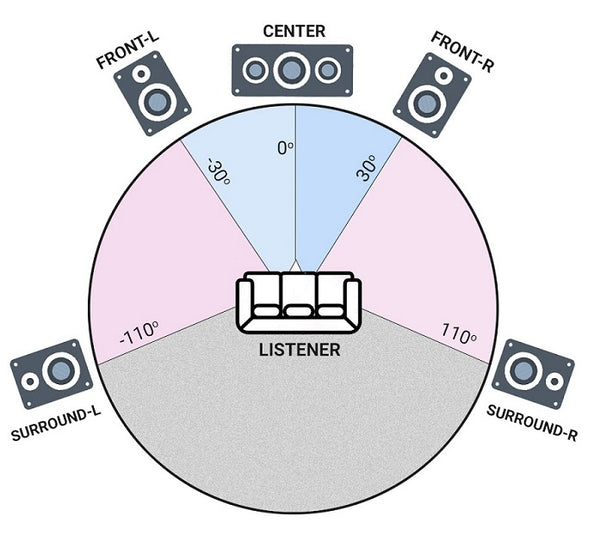
The popularity of home theatre systems continues to climb rapidly as people switch to consuming digital content at home, as a common form of entertainment, given the implications of the post-pandemic world. But the confusion arises when we ask, which one is a better option, 5.1 or 7.1 surround sound? Does 7.1 sound offer a substantial enough improvement over 5.1 systems to make it desirable for your home theatre?
If you’ve been questioning exactly what kind of sound system to get, it would be a good idea to have an objective look at both surround sound setups. What is appropriate for you depends on a number of various variables, including personal preferences, so let’s jump right in, and discuss the differences.
First, the bare basics of surround sound
A 5.1 surround sound has a front left, front right, front centre, surround right and surround left speakers along with a subwoofer.
A 7.1 surround sound system has an additional set of rear surround speakers, while the rest of the setup is similar to a 5.1 surround sound system. The use of additional surround rear speakers works exceptionally well in larger living spaces. But, some living spaces may not have sufficient space for the arrangement of an additional set of speakers at the back.
Pros and cons of 5.1 and 7.1

A 5.1 system comes with five small speakers and one subwoofer that handles the bass. The centre speaker sits directly in front of your listening position, under your TV. Two front speakers are based on either side of the TV. The remaining two speakers usually sit to either side of your preferred listening position, like on both sides of your couch. The subwoofer is usually placed in a corner, or to one side of your television set.
The best thing about 5.1 systems is that they are self-contained, eliminating the need for buying additional equipment. It is mostly a right out of the box solution. They usually come with their own receiver that connects your speakers to your TV. However, for bigger rooms, a 5.1 sound system may not deliver the most stellar, immersive sound experience of an audiophile-grade.
A 7.1 system that has the same set up with two additional speakers that are identical to the ones on either side of your listening position, positioned behind it. You can bolt them to the wall, facing ear levels to get the full surround sound effect. They pack a punch with the added power of two additional surround speakers. For a deeper surround sound listening experience in a large, sprawling space, a 7.1 system is a no-brainer choice. They offer lossless audio which is similar to the movie studio’s original. However, the theatre-quality sound experience that a 7.1 system offers comes with some disadvantages.
They are definitely more expensive and difficult to set up as compared to a 5.1 system.
To determine what sound system is an ideal fit for you, also factor in the room size, furnishings and listening position.
Room size: If you have a smaller room (less than 350 sq feet), and try to fit in a 7.1 system, it can end up creating a muddy, louder mix of sounds. For a room of this size, a 5.1 system is the best pick.Furnishings: If there are too many hard material objects like tables, desks, chairs etc. in your room, they will reflect the sound and the whole purpose of a better audio experience will be defeated. Having more couches and carpeting in the room will significantly counter this problem.Listening position: A 7.1 system requires speakers to be put at a distance behind the listener. If there is not sufficient space behind the listening area in the living room then it’s best to skip having a 7.1 sound system installed and go for the fairly standard 5.1 sound system.
5.1 setups are a good pick for music listening, and the most popular choice for home theatre enthusiasts. 5.1 has both wired and wireless solutions. It’s a cool upgrade to the sound coming out of your TV. But if you want to get access to more surround sound formats 7.1 is for you. Remember though that 7.1 systems require 7.1 compatible A/V receivers. It is capable of rendering a richer sound experience but comes with an expensive price premium. Snag a 5.1 surround sound package if you want to keep things more affordable and have space constraints.
Here’s a quick comparison between 5.1 and 7.1 systems
5.1 Surround Sound |
7.1 Surround Sound |
| 5 Standard Channels +1 Subwoofer | 7 Standard Channels + 1 Subwoofer |
| Ideal for Small to Medium Rooms | Ideal for Large Rooms |
| Available in Dolby Digital and DTS Format | Available in Dolby TrueHD, DTS-HD Master Audio Format |
| Relatively Cheaper Than 7.1 System | More Expensive Than 5.1 System |
| It offers the ease of simpler set up | It requires more involved configuration |
A word on Dolby Atmos to make movie-watching an immersive experience
Dolby Atmos is powerful enough to deeply immerse you in a stellar sound experience. Sound can have an indelible impact on the movie-watching experience and Dolby Atmos is a 3-dimensional sound format. If you’re looking to replicate the big-screen experience at home (we certainly are :-)), installing extra speakers (2 or 4) placed up high in the ceiling, will create an ideal Dolby Atmos setup.
For more information, you can reach out to us at Ooberpad, for a proper walkthrough and help enhance your home entertainment experience.
FAQs
1. Should I choose a 5.1 or 7.1 system for my home theater?
Choosing between a 5.1 or 7.1 system depends on your room size and your preference for sound quality:
-
5.1 systems are perfect for smaller rooms and provide a rich, balanced sound experience for movies, gaming, and TV shows.
-
7.1 systems are better for larger rooms and those seeking a more immersive, detailed surround sound experience. The extra speakers help create a more enveloping audio atmosphere.
2. Can I upgrade from a 5.1 to a 7.1 or Dolby Atmos system?
Yes, you can upgrade your home theater from a 5.1 system to 7.1 or even Dolby Atmos. To upgrade, you’ll need additional speakers (such as side surround or overhead speakers) and an AV receiver that supports the extra channels. A Dolby Atmos receiver will be required if you want to add height channels for a truly immersive sound experience.
3. What is the ideal room size for a 5.1 or 7.1 home theater system?
-
5.1 systems work well in small to medium-sized rooms (up to 300 square feet), providing a good balance between sound clarity and space requirements.
-
7.1 systems are ideal for larger rooms (over 300 square feet), as the additional speakers enhance the surround sound and help fill the space with more detailed and immersive audio.
4. Do I need a subwoofer for a 5.1 or 7.1 system?
Yes, a subwoofer is an essential part of both 5.1 and 7.1 systems. It provides low-frequency sounds (bass), adding depth to your audio experience. A subwoofer helps enhance explosions, music, and sound effects, ensuring that you feel the full impact of the audio.
5. Is a 7.1 system better than a 5.1 system for movies?
Yes, a 7.1 system provides a more detailed and expansive sound experience, especially in larger rooms. The additional rear surround speakers in a 7.1 system create a more precise, immersive environment, making it perfect for movies and action-packed content. However, a 5.1 system still delivers great performance in most situations, especially in smaller rooms.
6. Can I add more speakers to my current 5.1 system to upgrade to 7.1?
Yes, you can easily upgrade your 5.1 system to a 7.1 system by adding two more surround speakers and a compatible AV receiver that supports 7.1 channels. Many AV receivers allow you to add extra speakers and expand your system without major modifications.
7. What type of content supports Dolby Atmos?
Dolby Atmos is supported by a wide range of content, including:
-
Movies: Many blockbuster films and streaming platforms like Netflix, Amazon Prime Video, and Disney+ offer Dolby Atmos support.
-
Gaming: Next-gen consoles like the PlayStation 5 and Xbox Series X support Dolby Atmos for gaming, providing a highly immersive sound experience.
-
Music: Some streaming services like Apple Music and Tidal offer Dolby Atmos music, allowing you to experience spatial audio in your home theater setup.







